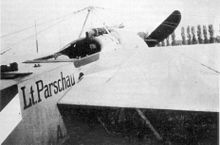Dicta Boelcke
Completed in June 1916, it was distributed throughout the German Army's Air Service (Die Fliegertruppen des Deutschen Reiches), some two years before the French and British militaries followed suit with their own tactical guides.
Often flying with Max Immelmann, Boelcke gained experience in the new realm of aerial combat as he discovered the utility of having a wingman, of massing fighter planes for increased fighting power, and of flying loose formations allowing individual pilots tactical independence.
Based on his successful combat experiences, he used his training as a professional soldier and his powers as an analytic thinker to design tactics for the use of aircraft in battle.
[1] During this period of pioneering aerial warfare, the British Royal Flying Corps air effort could be summed up by "Attack everything".
[2] During early 1916, Boelcke wrote a brochure entitled "Experiences of Air Fighting", giving tips for attacking any one of three types of opposing aircraft.
[3] After Immelmann's death, Boelcke was withdrawn from combat on 27 June 1916, while he was the war's leading ace, and assigned to Fliegertruppe (Flying Troops) headquarters.
The most prominent example of this was Manfred von Richthofen, leading ace of the war and assigned to command the most successful German squadron, Jasta 11.
As a result of Boelcke's tactical concepts, the Imperial German Air Service exacted an ever greater toll on Allied aircraft right up until war's end.
[10] When the next logical step was taken by the Germans in organizing fighter squadrons into a wing in June 1917, Richthofen was picked to lead it.
During the early days of World War II, South African ace Sailor Malan espoused his Ten Rules for Air Fighting.



